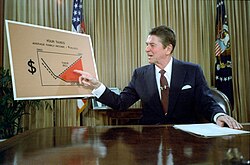Trickle-down economics
Trickle-down economics is an economic theory: if you tax less the businesses and the wealthy, then that should make it easier for them to invest and create businesses. This will help them but also help those poorer or less rich. Hence the "trickle-down" effect from the rich to poor.
It does not always work. Some people have accused supply-side economics, such as "Reaganomics" for naively believing that trickle down economics would help everybody.
General supply-side theory wants to lower taxes for everyone. But trickle-down theory more specifically wants to lower taxes for the rich (the upper end of the economic spectrum).[1][2]
Trickle-down Economics Media
Ronald Reagan's economic policies, dubbed "Reaganomics" by opponents, included large tax cuts and were characterized as trickle-down economics. In this picture, he is outlining his plan for the Economic Recovery Tax Act of 1981 from the Oval Office in a televised address, July 1981.
William Jennings Bryan, who criticized trickle-down theory in his Cross of Gold speech in 1896
References
- ↑ Amadeo, Kimberly (April 29, 2017). "Why Trickle Down Economic Works in Theory But Not in Fact". The Balance. https://www.thebalance.com/trickle-down-economics-theory-effect-does-it-work-3305572.
- ↑ Crouse, Eric R. (2013). The Cross and Reaganomics: Conservative Christians Defending Ronald Reagan. Rowman & Littlefield. p. 31.

